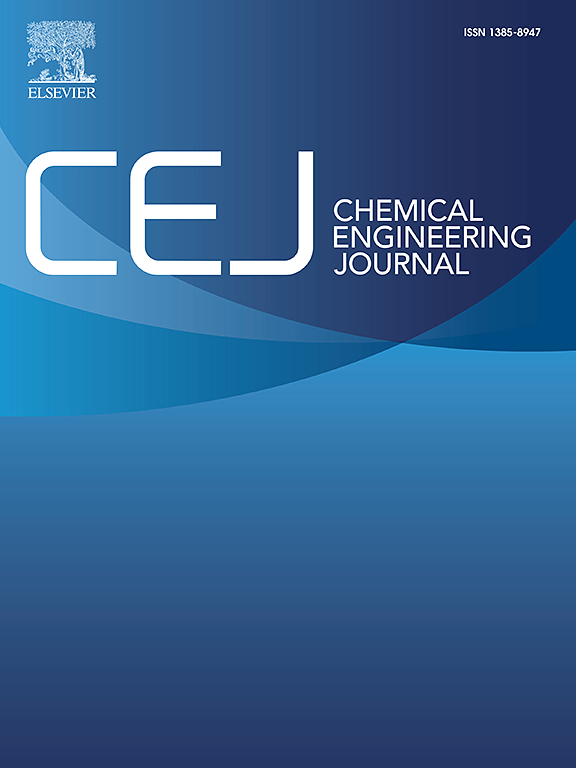芳香族二亚胺桥接n-苯咔唑的原位电聚合作为长效正阴离子共蓄电池高压正极材料
IF 13.2
1区 工程技术
Q1 ENGINEERING, CHEMICAL
引用次数: 0
摘要
具有大π缺电子骨架和固有电活性官能团的有机电极材料有望成为二次电池中的先进阴极材料。然而,传统的有机阴极通常存在比容量低、电子/离子导电性差以及在电解质中溶解度高等问题。在本研究中,我们报告了一种高效的分子工程策略,即在芳香族二亚胺的两侧加入 N-苯基咔唑(NPC)基团作为 N-取代基,从而获得二(N-苯基咔唑)萘/苯二亚胺(即 DNPC-XDI,其中 X = N、B)。引入的缺电子 NPC 基团可在外加电场条件下诱导 DNPC-XDI 原位电聚合,还可作为 p 型阴离子存储位点,实现优异的阳离子和阴离子共存储,显著提高工作电压、比容量和速率能力。综合表征结果表明,Poly(DNPC-XDI) 阴极通过阳离子-阴离子混合共氧化还原机制运行,涉及 C=O 功能基团上 Li+ 阳离子的负载/脱落以及聚咔唑骨架上 PF6- 阴离子的同时掺杂/去掺杂行为。由此产生的 Poly(DNPC-XDI)(X = N,B)显示出卓越的电化学性能,包括 4.3 V 的高截止电压,以及在 100 mA g-1 的电流密度下分别达到 359.2 和 237.5 mAh g-1 的可逆比容量。令人印象深刻的是,即使在 10 A g-1 的更高电流密度下,Poly(DNPC-XDI) (X = N, B) 在循环 10,000 次后仍能保持 100.5 和 75.0 mAh g-1 的可逆比容量,这证明了它们出色的速率性能和循环稳定性。理论计算显示,锂化过程在能量上是有利的,而且不会形成π-π堆叠结构。这项研究为合理设计分子结构和高效的原位电化学聚合方法提供了宝贵的见解,有助于优化有机阴极材料,实现高性能的阳离子-阴离子协同二次电池。本文章由计算机程序翻译,如有差异,请以英文原文为准。
In-situ electro-polymerization of aromatic diimide bridged N-phenylcarbazole as high-voltage cathode materials for long-lasting cationic and anionic co-storage batteries
Organic electrode materials with large π electron-deficient backbones and inherently electroactive functional groups hold great promise for serving as advanced cathode materials in secondary batteries. However, conventional organic cathodes were usually plagued by low specific capacity, poor electronic/ionic conductivity, and high solubility in electrolytes. In this study, we report an efficient molecule engineering strategy to incorporate N-phenylcarbazole (NPC) groups as N-substituents on both sides of aromatic diimides to obtain di(N-phenylcarbazole) naphthalene/benzene diimides (namely DNPC-XDI, where X = N, B). The introduced electron-deficient NPC groups could induce the in-situ electro-polymerization of DNPC-XDI under applied field conditions, and also function as p-type anion-storage sites to achieve exceptional cationic and anionic co-storage with significantly enhanced operation voltage, specific capacity and rate capability. Comprehensive characterizations unveiled that the Poly(DNPC-XDI) cathodes operate through a hybrid cation–anion co-redox mechanism, involving the loading/detaching of Li+ cations on C=O functional groups and the concurrent doping/de-doping behavior of PF6− anions on Poly-carbazole backbones. The resultant Poly(DNPC-XDI) (X = N, B) displayed remarkable electrochemical performances, including a high cut-off voltage of 4.3 V and reversible specific capacities of 359.2 and 237.5 mAh g−1 at a current density of 100 mA g−1. Impressively, even at a significantly higher current density of 10 A g−1, the Poly(DNPC-XDI) (X = N, B) still maintained reversible specific capacities of 100.5 and 75.0 mAh g−1 after 10,000 cycles, confirming their outstanding rate performance and cycling stability. Theoretical calculations revealed that the lithiation process was energetically favourable and without the formation of π-π stacking structures. This study offers valuable insights into the rational design of molecular structures and efficient in-situ electrochemical polymerization methods for optimizing organic cathode materials to achieve high-performance cationic-anionic synergistic secondary batteries.
求助全文
通过发布文献求助,成功后即可免费获取论文全文。
去求助
来源期刊

Chemical Engineering Journal
工程技术-工程:化工
CiteScore
21.70
自引率
9.30%
发文量
6781
审稿时长
2.4 months
期刊介绍:
The Chemical Engineering Journal is an international research journal that invites contributions of original and novel fundamental research. It aims to provide an international platform for presenting original fundamental research, interpretative reviews, and discussions on new developments in chemical engineering. The journal welcomes papers that describe novel theory and its practical application, as well as those that demonstrate the transfer of techniques from other disciplines. It also welcomes reports on carefully conducted experimental work that is soundly interpreted. The main focus of the journal is on original and rigorous research results that have broad significance. The Catalysis section within the Chemical Engineering Journal focuses specifically on Experimental and Theoretical studies in the fields of heterogeneous catalysis, molecular catalysis, and biocatalysis. These studies have industrial impact on various sectors such as chemicals, energy, materials, foods, healthcare, and environmental protection.
 求助内容:
求助内容: 应助结果提醒方式:
应助结果提醒方式:


